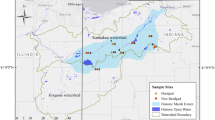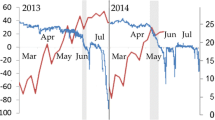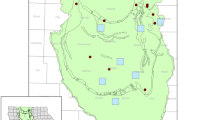Abstract
Waterfowl and migratory birds rely on wetland habitat in coastal temperate regions for breeding and feeding. Over the past few decades, freshwater impoundments have been created in the Cumberland Marsh Region of Canada to compensate for regional loss of ecosystem services and habitat. The objective of our study was to determine whether freshwater impoundments underlain by tidal marsh sediments, and located where marine influences exist, are predisposed to higher nutrient levels and more conducive to productive habitat than waterfowl habitat elsewhere in Canada and the northeastern United States. We found that impoundment subsurface waters were generally circumneutral with moderate concentrations of dissolved organic carbon ranging between 6.30 and 13.90 mg/L. Furthermore, these impoundments generally had higher concentrations of cations (Ca, K, Mg, Na), anions (Cl−, SO42−), and nutrients (phosphorus, nitrogen, dissolved organic carbon) than other freshwater waterbodies studied for waterfowl in central Ontario, Maine and Nova Scotia, but lower concentrations than found in Prairie potholes. Our data indicate that a lack of hydrological connectivity and nutrient pathways may be limiting impoundments from reaching their full potential for supporting wildlife. We recognize that additional research on fostering ecosystem services from wetland restoration and creation projects is necessary on former tidal marshland.


Similar content being viewed by others
References
Anderson MG, Alisauskas RT, Batt BDJ, Blohm RJ, Higgins KF, Perry MC, Ringelman JK, Sedinger JS, Serie JR, Sharp DE, Trauger DL, Williams CK (2018) The migratory bird treaty and a century of waterfowl conservation. Journal of Wildlife Management 82(2):247–259
Badiou P, McDougal R, Pennock D, Clark B (2011) Greenhouse gas emissions and carbon sequestration potential in restored wetlands of the Canadian prairie pothole region. Wetlands Ecology and Management 19(3):237–256
Ballantine K, Schenider R (2009) Fifty-five years of soil development in restored freshwater depressional wetlands. Ecological Applications 19(6):1467–1480
Banks LK (2013) Impact of water chemistry on invertebrate communities in agricultural wetlands in the Annapolis Valley, Nova Scotia. In: Honours Thesis. Acadia University, Canada
Bleakney JS (2004) Sods, soils and spades. McGill-Queen’s University Press, Canada
Boone LK, Ollerhead J, Barbeau MA, Beck AD, Sanderson BG, McLellan NR (2017) Returning the tide to dikelands in a macrotidal and ice-influenced environment: challenges and lessons learned. In: Finkl CW, Makowski C (eds) Coastal wetlands: alteration and remediation. Springer, Florida, pp 705–749
Bortolotti LE, Vinebrooke RD, St. Louis VL (2016) Prairie wetland communities recover at different rates following hydrological restoration. Freshwater Biology 61(11):1874–1890
Canadian Council of Ministers of the Environment (2004) Phosphorus: Canadian guidance framework for the management of freshwater systems. Retrieved from http://ceqg-rcqe.ccme.ca/download/en/205
Choi YD, Temperton VM, Allen EB, Grootjans AP, Halassy M, Hobbs RJ, Naeth MA, Torok K (2008) Ecological restoration for future sustainability in a changing environment. Ecoscience 15(1):53–64
Corstanje R, Reddy KR (2004) Response of biogeochemical indicators to a drawdown and subsequent reflood. Journal of Environmental Quality 33(6):2357–2366
Curtis PJ, Adams HE (1995) Dissolved organic matter quantity and quality from freshwater and saltwater lakes in east-Central Alberta. Biogeochemistry 30:59–76
Davies SR, Sayer CD, Greaves H, Siriwardena GM, Axmacher JC (2016) A new role for pond management in farmland bird conservation. Agriculture, Ecosystems & Environment 233:179–191
De Wilde M, Puijalon S, Vallier F, Bornette G (2015) Physico-chemical consequences of water-level decreases in wetlands. Wetlands 35(4):683–694
Drexler JZ, Krauss KW, Sasser MC, Fuller CC, Swarzenski CM, Powell A, Swanson KM, Orlando J (2013) A long-term comparison of carbon sequestration rates in impounded and naturally tidal freshwater marshes along the lower Waccamaw River, South Carolina. Wetlands 33(5):965–974
Driver EA, Peden DG (1977) The chemistry of surface water in prairie ponds. Hydrobiologia 52(1):33–48
Dunnington D, White H, Spooner I, Mallory ML, White C, O’Driscoll N, McLellan N (2017) A paleolimnological archive of metal sequestration and release in the Cumberland Basin marshes, Atlantic Canada. FACETS 2:440–460
Español C, Gallardo B, Pino MR, Martín A, Comín FA (2013) Is net ecosystem production higher in natural relative to constructed wetlands? Aquatic Sciences 75(3):385–397
Euliss NH, LaBaugh JW, Fredrickson LH, Mushet DM, Laubhan MK, Swanson GA, Winter TC, Rosenberry DO, Nelson RD (2004) The wetland continuum: a conceptual framework for interpreting biological studies. Wetlands 24(2):448–458
Euliss NH, Mushet DM, Newton WE, Otto CR, Nelson RD, LaBaugh JW, Scherff EJ, Rosenberry DO (2014) Placing prairie pothole wetlands along spatial and temporal continua to improve integration of wetland function in ecological investigations. Journal of Hydrology 513:490–503
Galatowitsch SM, Valk AG (1996) Vegetation and environmental conditions in recently restored wetlands in the prairie pothole region of the USA. Plant Ecology 126(1):89–99
Ganong WF (1903) The vegetation of the bay of Fundy salt and diked marshes: an ecological study. Botanical Gazette 36(3):161–186
Goldhaber MB, Mills CT, Morrison JM, Stricker CA, Mushet DM, LaBaugh JW (2014) Hydrogeochemistry of prairie pothole region wetlands: role of long-term critical zone processes. Chemical Geology 387:170–183
Gordon DC, Cranford PJ, Desplanque C (1985) Observations on the ecological importance of salt marshes in the Cumberland Basin, a macrotidal estuary in the bay of Fundy. Estuarine, Coastal and Shelf Science 20:205–227
Government of Canada (1991) The Federal policy on wetland conservation. Retrieved from http://nawcc.wetlandnetwork.ca/Federal%20Policy%20on%20Wetland%20Conservation.pdf
Government of Canada (2017) Tintamarre national wildlife area Retrieved from https://www.canada.ca/en/environment-climate-change/services/national-wildlife-areas/locations/tintamarre.html. April 9 2018
Government of Nova Scotia (2011) Nova Scotia wetland conservation policy. Retrieved from https://novascotia.ca/nse/wetland/docs/Nova.Scotia.Wetland.Conservation.Policy.pdf
Hicklin PW (1987) The migration of shorebirds in the bay of Fundy. The Wilson Bulletin 99:540–570
Jessop J, Spyreas G, Pociask GE, Benson TJ, Ward MP, Kent AD, Matthews JW (2015) Tradeoffs among ecosystem services in restored wetlands. Biological Conservation 191:341–348
Johnson DH, Grier JW (1988) Determinants of breeding distributions of ducks. Wildlife Monographs 100:3–37
Kadlec RH, Reddy KR (2001) Temperature effects in treatment wetlands. Water Environment Research 73:543–557
Korosi JB, Ginn BK, Cumming BF, Smol JP (2013) Establishing past environmental conditions and tracking long-term environmental change in the Canadian maritime provinces using lake sediments. Environmental Reviews 21:15–27
Krapu GL, Reinecke KJ (1992) Foraging ecology and nutrition. In: Batt BDJ, Afton AD, Anderson MG, Ankney CD, Johnson DH, Kadlec JA, Krapu GL (eds) Ecology Management of Breeding Waterfowl. University of Minnesota Press, Minneapolis, pp 1–29
Lieske DJ, MacIntosh M, Millet L, Bondrup-Nielsen S, Pollard JB, Parsons G, McLellan NR, Milton GR, MacKinnon F, Connor K, Banks LK (2018) Modelling the impacts of agriculture in mixed-use landscapes: a review and case study involving two species of dabbling ducks. Landscape Ecology 33(1):35–57
Loder AL, Mallory ML, Spooner I, McLauchlan C, Englehardt PO, McLellan N, White C (2016) Bioaccumulation of lead and arsenic in gastropods inhabiting salt marsh ponds in coastal bay of fundy, Canada. Water Air and Soil Pollution 227(3)
Loder AL, Mallory ML, Spooner IS, McLellan N, White C, Smol JP (2018a) Do rural impoundments in coastal bay of Fundy, Canada provide adequate habitat for wildlife? Wetlands Ecology and Management 26(2):213–230
Loder AL, Mallory ML, Spooner IS, Turner M, McLellan N (2018b) Nutrient availability reduced in older rural impoundments in coastal bay of Fundy. Canada Hydrobiologia 814:175–189
Longcore JR, McAuley DG, Pendelton GW, Bennatti CR, Mingo TM, Stromborg KL (2006) Macroinvertebrate abundance, water chemistry, and wetland characteristics affect use of wetlands by avian species in Maine. Hydrobiologia 567:143–167
Ma Z, Cai Y, Li B, Chen J (2010) Managing wetland habitats for waterbirds: an international perspective. Wetlands 30(1):15–27
Mallory ML, McNicol DK, Cluis DA, Laberge C (1998) Chemical trends and status of small lakes near Sudbury, Ontario, 1983-1995: evidence of continued chemical recovery. Canadian Journal of Fisheries and Aquatic Sciences 55(1):63–75
McCabe AJ, Arnold WA (2016) Seasonal and spatial variabilities in the water chemistry of prairie pothole wetlands influence the photoproduction of reactive intermediates. Chemosphere 155:640–647
McNicol DK, Bendell BE, Mallory ML (1995a) Evaluating macroinvertebrate responses to recovery from acidification in small lakes in Ontario, Canada. Water Air and Soil Pollution 85(2):451–456
McNicol DK, Mallory ML, Kerekes JJ (1996) The Canadian Wildlife Service LRTAP Biomonitoring Program. Part 3, Site locations, physical, chemical and biological characteristics. Canadian Wildlife Service, Technical Report No 248, p 215
McNicol DK, Mallory ML, Laberge C, Cluis DA (1998) Recent temporal patterns in the chemistry of small, acid-sensitive lakes in Central Ontario, Canada. Water Air and Soil Pollution 105:343–351
McNicol DK, Mallory ML, Wedeles CHR (1995b) Assessing biological recovery of acid-sensitive lakes in Ontario, Canada. Water Air and Soil Pollution 85(2):457–462
Mitsch WJ, Gosselink JG (2015) Wetlands, 5th edn. Wiley, Hoboken
Mitsch WJ, Wilson RF (1996) Improving the success of wetland creation and restoration with know-how, time, and self-design. Ecological Applications 6(1):77–83
Mitsch WJ, Wu X, Nairn RW, Weihe PE, Wang N, Deal R, Boucher CE (1998) Creating and restoring wetlands. BioScience 48(12):1019–1030
New Brunswick Department of Natural Resources (2002) New Brunswick wetlands conservation policy. Retrieved from http://www2.gnb.ca/content/dam/gnb/Departments/nr-rn/pdf/Wetlands-TerresHumides.pdf
Niemuth ND, Fleming KK, Reynolds RE (2014) Waterfowl conservation in the US prairie pothole region: confronting the complexities of climate change. PLoS One 9(6):e100034
Nürnberg GK, LaZerte BD (2016) Trophic state decrease after lanthanum-modified bentonite (Phoslock) application to a hyper-eutrophic polymictic urban lake frequented by Canada geese (Branta canadensis). Lake and Reservoir Management 32(1):74–88
Portnoy JW, Giblin AE (1997) Effects of historic tidal restrictions on salt marsh sediment chemistry. Biogeochemistry 36(3):275–303
Reddy KR, Delaune RD (2008) Biogeochemistry of wetlands. Taylor & Francis Group, Florida
Ryan RJ, Boehner RC, Deal AJ, Calder JH (1990) Cumberland Basin geology map, Amherst, Springhill and Parrsboro. Digital version of Nova Scotia Department of Natural Resources Map ME 1990–12. https://novascotia.ca/natr/meb/download/dp033md.asp. Accesed April 2017
Scheuhammer AM, McNicol DK, Mallory ML, Kerekes JJ (1997) Relationships between lake chemistry and calcium and trace metal concentrations of aquatic invertebrates eaten by breeding insectivorous waterfowl. Environmental Pollution 96(2):235–247
Scott DB, Frail-Gauthier J, Mudie PJ (2014) Coastal wetlands of the world: geology, ecology, distribution and applications. Cambridge University Press, New York
Sharitz RR, Batzer DP (1999) An introduction to freshwater wetlands in North America and their invertebrates. In: Batzer DP, Rader RB, Wissinger SA (eds) Invertebrates in freshwater wetlands of North America: ecology and management. Wiley, New York, pp 1–21
Shaw J, Ceman J (1999) Salt-marsh aggradation in response to late-Holocene Sea-level rise at Amherst point, Nova Scotia. Canada Holocene 9(4):439–451
Simpson RL, Good RE, Leck MA, Whigham DF (1983) The ecology of freshwater tidal wetlands. BioScience 33(4):255–259
Smol JP (2009) Pollution of lakes and rivers: a paleoenvironmental perspective. Wiley
Staicer CA, Freedman B, Srivastava D, Dowd N, Kilgar J, Hayden J, Payne F, Pollock T (1994) Use of lakes by black duck broods in relation to biological, chemical, and physical features. Hydrobiologia 279(1):185–199
Thienpont JR, Ginn BK, Cumming BF, Smol JP (2008) An assessment of environmental changes in three lakes from King’s county (Nova Scotia, Canada) using diatom-based paleolimnological techniques. Water Quality Research Journal of Canada 43(2/3):85–98
Waiser MJ (2006) Relationship between hydrological characteristics and dissolved organic carbon concentration and mass in northern prairie wetlands using a conservative tracer approach: hydrology and DOC in prairie wetlands. Journal of Geophysical Research: Biogeosciences 111(G2)
Williams P, Whitfield M, Biggs J (2008) How can we make new ponds biodiverse? A case study monitored over 7 years. Hydrobiologia 597(1):137–148
Withey P, van Kooten GC (2011) The effect of climate change on optimal wetlands and waterfowl management in Western Canada. Ecological Economics 70(4):798–805
Wollenberg JT, Ollerhead J, Chmura GL (2018) Rapid carbon accumulation following managed realignment on the bay of Fundy. PLoS One 13(3):e0193930
Wynn G (1979) Late eighteenth-century agriculture on the bay of Fundy marshlands. Acadiensis 8(2):80–89
Yu L, Huang Y, Sun F, Sun W (2017) A synthesis of soil carbon and nitrogen recovery after wetland restoration and creation in the United States. Scientific Reports 7(1)
Zedler J (2000) Progress in wetland restoration ecology. Trends in Ecology & Evolution 15(10):402–407
Acknowledgments
Financial support for this project was provided by the Natural Sciences and Engineering Research Council of Canada, the Canada Research Chairs program, Environment and Climate Change Canada’s National Wetlands Conservation Fund, Ducks Unlimited Canada and Acadia University. Thanks to Andrew Kennedy and the Canadian Wildlife Service for logistic support and providing a research permit for field work. We thank Adam Campbell and the reviewers for providing helpful comments on an earlier version of this manuscript.
Author information
Authors and Affiliations
Corresponding author
Electronic supplementary material
ESM 1
(DOCX 60 kb)
Rights and permissions
About this article
Cite this article
Loder, A.L., Spooner, I.S., McLellan, N.R. et al. Water Chemistry of Managed Freshwater Wetlands on Marine-Derived Soils in Coastal Bay of Fundy, Canada. Wetlands 39, 521–532 (2019). https://doi.org/10.1007/s13157-018-1101-y
Received:
Accepted:
Published:
Issue Date:
DOI: https://doi.org/10.1007/s13157-018-1101-y




